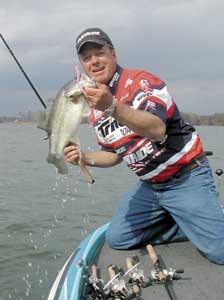
This month, depending upon weather and what lake you’re fishing, you’re probably fishing for bass sometime around the spawn.
And that’s a perfect time to fish a floating worm.
A floating worm isn’t technically a topwater bait, but it’s close to it. You will get to see some ferocious strikes; a lot of fish will blow up on it, and you’ll at least to get to see most of the fish strike at it. Plus, it’s a great way to catch a lot of fish — plus some big fish.
I catch quality fish with a floating worm in all stages of the spawn, but you really do better with a floating worm than, say, a spinnerbait, when fish are at the peak of the spawn or postspawn.
In clear water, you can catch a lot of prespawn fish, and you can catch a lot of spawning or postspawn fish. It’s really just a good bait to use throughout the entire period.
You can fish a floating worm at just about any Carolinas lake; you can fish it in stained water, but it’s best in clear water. If I can drop a bubblegum worm down 18 inches and still see it, I’ll throw it. You just go down the bank and throw it. You’ll see most of the fish as they come out and take a whack at it.
Now, I’ll admit I do own some spinning rods, and a lot of people fish a floating worm with a spinning rod, but I don’t. I fish them on a 6- or 6 1/2-foot medium-action All-Star baitcasting rod with a Pfleuger Presidential reel, a bait-caster with a 6.3-to-1 retrieve ratio.
I use 12- to 14-pound Berkley Sensation mono because it’s extremely low stretch, which you need when you’re setting the hook on a fish that’s hit a floating worm.
If I need to make long casts, I’ll use the 6 1/2-foot rod; if I’m fishing somewhere I need more control, like fishing around a lot of willows or skipping it back under a dock, I’ll use the 6-footer. With either one, you can cover a lot of water.
You can rig a floating worm weedless or with the hook showing. Most of the time, I’m fishing it near some kind of cover, so I rig it weedless. When I do, I use a 3/0 Owner “J” hook. If I’m fishing it with the hook exposed, I’ll use a 3/0 Owner straight-shank hook.
About 90 percent of the time, I fish a floating worm with a little barrel swivel a foot or so up the line; that keeps line twist out and gives you a little more weight so it’ll cast better on a bait-caster.
Like most fishermen, when I’m fishing a floating worm, I’m using bright colors. It’s easier for me to see a bubblegum worm when I’m working it along, a foot or so under the surface, but I think the brighter colors are more effective for drawing strikes from bass.
I think it has to do with them being more aggressive because they’re going on the bed or protecting their fry, and I think the bright colors may trigger them a little. A floating worm doesn’t put out any kind of vibration, like a spinnerbait, so it’s a visual strike.
I’ll fish one of four colors 99 percent of the time: bubblegum, yellow, merthiolate or white.
If I’m fairly sure I’m going to be using a floating worm a lot, I’ll have all four colors rigged before I leave home. I’ll just start with one and keeping trying them.
If I’m fishing with somebody else, I’ll start with one color and have them start with another, letting the fish decide what they want that day. And believe me, the color they want will change from day to day.
As far as action is concerned, I’ll let a floating worm sink just a little bit after I make my cast, then I’ll work it back the way I work a hard jerkbait or a stickbait. I’ll fish it with a twitch-twitch-pause action, and most of the time, they get it on the pause.
You’ll catch a lot of fish using a floating worm just going down the bank because there are so many fish shallow. But the real draw for me is that you’ll catch a lot of big fish.
They’re in there to spawn, and a floating worm just does something to trigger them into striking.
It’s a great bait.
Davy Hite is a 40-year-old native of Saluda, S.C., who now resides in Ninety Six, S.C. He has fished professionally since 1993, when he qualified for his first Bassmasters Classic. He was the BASS Angler of the Year in 1997 and 2002, and he has won the 1999 Bassmasters Classic and the 1998 FLW Tour Championship. He is sponsored by Triton boats, Evinrude outboards, All-Star rods, Pfleuger reels, Pure Fishing (Berkeley), Owner hooks and Solar-Bat sunglasses.




Be the first to comment